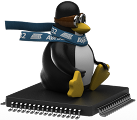AT91SAM9x5 family special page
(for SAM9G15, SAM9G25, SAM9X25, SAM9G35 and SAM9X35)
Introduction
|
|
Hi! Welcome to the Linux4SAM page dedicated to the newly introduced AT91SAM9X5 family. This page will cover the following chips:
* at91sam9g15
* at91sam9g25
* at91sam9x25
* at91sam9g35
* at91sam9x35
and the associated Evaluation Kit.
This page provides the latest information on this eMPU series in the same way as elsewhere on the site Linux4SAM. Each component is detailed in its own section just below.
As is always done for the material we publish on Linux4SAM, These special releases will be integrated in each component release cycle and the associated Open Source upstream project.
\ |
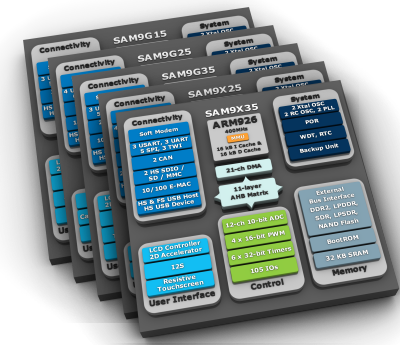 |
|
|
|
Basic components
Pre-built binaries
|
|
| Board |
Description |
Binary |
| !NandFlash |
| at91sam9x5ek |
AT91Bootstrap binary with 2nd level application in NandFlash |
boot.bin |
| SD Card |
| at91sam9x5ek |
AT91Bootstrap binary with 2nd level application in Micro SD Card |
at91sam9x5ek-sdcardboot-3.1.bin
rename it as BOOT.BIN while loading it on SD card. |
|
|
|
Boot capabilities matrix
Here is :

a summary of the boot feature for each board

the solution chosen for the Linux4SAM pre-built binaries.
|
|
| Product |
Boot from
SerialFlash (SPI0 CS0) |
Boot from
SerialFlash (SPI0 CS1) |
Boot from
NAND Flash |
Boot from
SD card |
Boot from
TWI EEPROM |
| at91sam9x5ek |
 |
 |
 |
 |
 |
|
|
|
Using AT91Bootstrap binaries
Boot from NAND flash with AT91Bootstrap
You will have to use SAM-BA to flash AT91Bootstrap. Here we are assuming you want to boot from NAND FLASH:
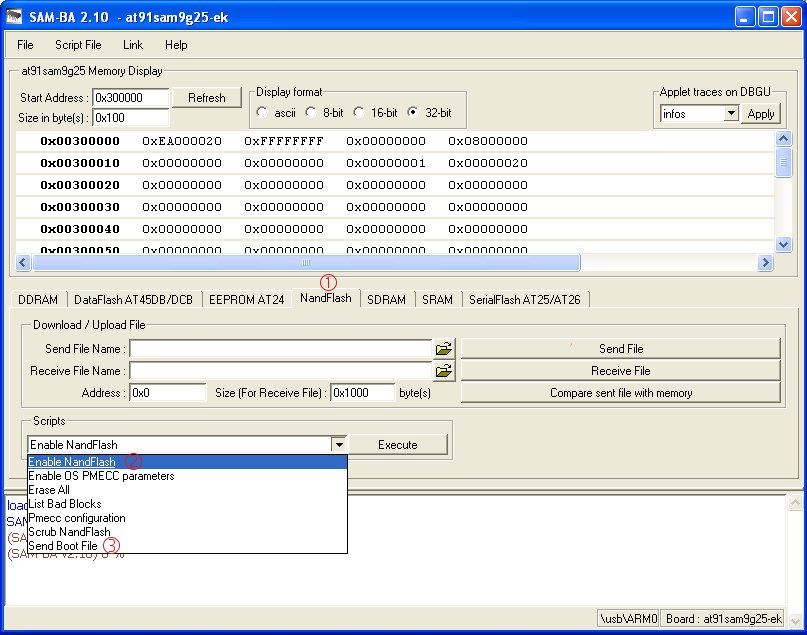
1. Choose the NandFlash media tab in the SAM-BA GUI.
2. Initialize the media choosing the
Enable NandFlash action in the
Scripts rolling menu and press
Execute.
3. Select
Send Boot File in the
Scripts rolling menu and press
Execute. Then select the bootstrap file and press
Open; the media is written down.
4. Close SAM-BA, remove the USB cable.
Boot from SD card with AT91Bootstrap
You can boot from SD card. To do this, you will need a SD Card with a FAT16/32 partition as first partition. Then you will have to copy the AT91Bootstrap binary file and the U-Boot binary file. These files
must be respectively named
BOOT.BIN and
u-boot.bin.
AT91Booststrap has been created by Atmel to ease the loading of binaries from several boot media. The revision created for AT91SAM9x5 family is available on www.linux4sam.org FTP site:
AT91Bootstrap-5series_1.2.tgz
.
You have to get
AT91Bootstrap source code:
wget ftp://ftp.linux4sam.org/pub/at91bootstrap/AT91Bootstrap3.1/AT91Bootstrap-5series_1.2.tgz
tar xvzf AT91Bootstrap-5series_1.2.tgz
cd AT91Bootstrap-5series_1.2
Configuring AT91Bootstrap and choosing the boot media
Before building
AT91Bootstrap, you have to configure it for 5series boards and to indicate where you want your third stage bootloader to be located: in this example it will be U-Boot. If you want to run it from NAND FLASH use:
make at91sam9x5nf_defconfig
And if you want to run it from the SD card use:
make at91sam9x5sduboot_defconfig

Note that you may need to specify the
CROSS_COMPILE variable. This is done like explained hereafter.
Then you can customize the
AT91Bootstrap configuration with:
make menuconfig
Now you have to launch the
AT91Bootstrap cross-compilation:
make CROSS_COMPILE=<path_to_cross-compiler/cross-compiler-prefix->
path_to_cross-compiler is only needed if it is not in your PATH.
Usually
cross-compiler-prefix- looks like
arm-linux- ,
arm-elf- or
arm-none-linux-gnueabi- .
The result of this operation is a fresh
AT91Bootstrap binary located in the
binaries directory and called
at91sam9x5ek-xxxboot-3.1.bin corresponding to the binary ELF file called
at91sam9x5ek-xxxboot-3.1.elf.
-
at91sam9x5ek-nandflashboot-3.1.bin is the binary file able to boot the application located in NAND FLASH.
-
at91sam9x5ek-sdcardboot-3.1.bin is the binary file able to boot the application called u-boot.bin located in the FAT formated SD card.

Check additional information in the dedicated
AT91Bootstrap page on Android4sam
.
U-Boot binaries
Here are the U-Boot binaries, for this example the U-Boot environment is located into the NAND flash.
|
|
| Board |
Description |
Binary |
| !NandFlash |
| at91sam9x5ek |
u-boot binary with environment in *NandFlash*
based on U-Boot revision 2010.06 |
u-boot.bin |
|
|
|
U-Boot 2010.06 experimental patch
Flashing U-Boot
You will have to use SAM-BA to flash U-Boot. Here we are assuming you want to put U-Boot and its environment into the NAND FLASH:
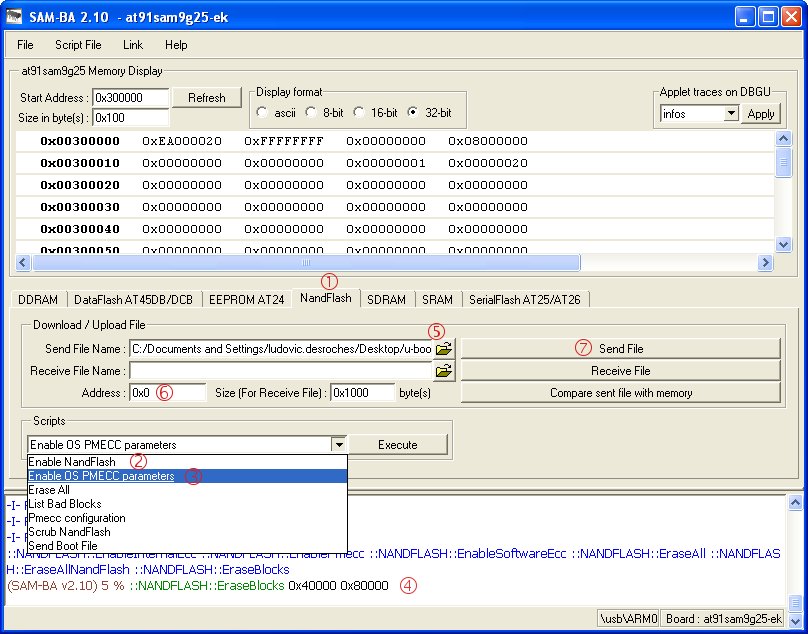
1. Choose the NandFlash media tab in the SAM-BA GUI.
2. Initialize the media choosing the
Enable NandFlash action in the
Scripts rolling menu and press
Execute.
3. Select
Enable OS PMECC parameters in the
Scripts rolling menu and press
Execute. The default ECC configuration should be ok so you should have this pop-up appearing:
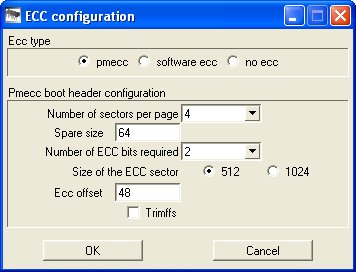
so press the
OK button.
4. To erase only the U-Boot part into the NAND FLASH, type this command after the SAM-BA prompt
:
NANDFLASH::EraseBlocks 0x40000 0xBFFFF
The SAM-BA EraseBlocks command takes two parameter: a start and an end address of FLASH that you want to erase.
5. Press
Send File Name Browse button and choose your U-Boot binary file.
6. Enter the proper address on media in the
Address text field. You can find the product map in
GettingStarted_9x5. So in our case, the value for U-Boot is 0x40000.
7. Press
Send File button.
8. Close SAM-BA, remove the USB cable.

Check additional information in the dedicated
U-Boot page.
Building U-Boot
Getting U-Boot sources
You have to get U-Boot source code:
wget ftp://ftp.denx.de/pub/u-boot/u-boot-2010.06.tar.bz2
tar xvjf u-boot-2010.06.tar.bz2
cd u-boot-2010.06
Or:
git clone http://git.denx.de/u-boot.git
cd u-boot
git checkout v2010.06
Then apply the at91 5series patch:
wget ftp://ftp.linux4sam.org/pub/uboot/u-boot-v2010.06/u-boot-5series_x.y.patch
patch -p1 < u-boot-5series_x.y.patch
Configuring U-Boot and choosing where the U-Boot environment resides
Before building U-Boot, you have to configure it for 5series boards and to indicate where you want to store the environment. If you want to store it in NAND FLASH use:
make at91sam9x5ek_nandflash_config
And if you want to store it into the DataFlash use:
make at91sam9x5ek_dataflash_config
Compiling U-Boot
Now you have to launch the U-Boot cross-compilation:
make CROSS_COMPILE=<path_to_cross-compiler/cross-compiler-prefix->
path_to_cross-compiler is only needed if it is not in your PATH.
Usually
cross-compiler-prefix- looks like
arm-linux- ,
arm-elf- or
arm-none-linux-gnueabi- .
The result of this operation is a fresh u-boot binary called
u-boot.bin corresponding to the binary ELF file called
u-boot.
-
u-boot.bin is the file you should store on the board
-
u-boot is the ELF format binary file you may use to debug u-boot through a JTAG link for instance.
Pre-built image
The kernel image is the same for the whole 5series. It will determine at runtime the particular SoC that it is running on.
Flashing the Linux kernel image
Using SAM-BA
The procedure to flash the kernel image is the
same as U-Boot, only two steps change:
1. Choose the NandFlash media tab in the SAM-BA GUI.
2. Initialize the media choosing the
Enable NandFlash action in the
Scripts rolling menu and press
Execute.
3. Select
Enable OS PMECC parameters in the
Scripts rolling menu and press
Execute. The default ECC configuration should be ok in the pop-up dialog box so just press the
OK button.
4. To erase only the U-Boot part into the NAND FLASH, type this command after the SAM-BA prompt:
NANDFLASH::EraseBlocks 0x200000 0x7FFFFF
The SAM-BA EraseBlocks command takes two parameter: a start and an end address of FLASH that you want to erase.
5. Press
Send File Name Browse button and choose your kernel image.
6. Enter the proper address on media in the
Address text field. You can find the product map in
GettingStarted_9x5. So in our case, the value for the kernel image is 0x200000.
7. Press
Send File button.
8. Close SAM-BA, remove the USB cable.
Using U-Boot
You can also flash the kernel image with U-Boot. You must have configured your network access in U-Boot as the binary image will be transferred to the target using TFTP protocol.
Type the following commands:
tftp 0x22000000 uImage-2.6.39-r1-at91sam9x5ek.bin
nand erase 0x200000 0x600000
nand write 0x22000000 0x200000 0x250000
boot
Note that last parameter is the actual size of the binary written. You may adapt it to the size of your kernel image.
Linux4SAM AT91SAM9x5 Experimental Patches
- Support for AT91SAM9x5 family ( SAM9G15, SAM9G25, SAM9X25, SAM9G35 and SAM9X35)
- DMA use on SD/MMC, SSC (I2S) audio, SPI and NAND flash peripherals
- NAND hardware ECC support using PMECC controller
- LCD with overlays and 2D acceleration
- ISI support using Video4Linux2 SoC interface
- Qtouch touch button
- CAN bus support for SAM9X25 and SAM9X35
- usual USB High-Speed and Ethernet (dual Ethernet on SAM9X25)
AT91SAM9x5 Linux kernel sources summary table

Check additional information in the dedicated
Linux Kernel page.
Building the Linux kernel
Getting source code
The at91 5series patch is based on the 2.6.39 Linux kernel version, so the first step is to get it:
wget http://www.kernel.org/pub/linux/kernel/v2.6/linux-2.6.39.tar.bz2
tar xvjf linux-2.6.39.tar.bz2
cd linux-2.6.39
Now you have to apply the Atmel patch series:
Download experimental patch archive:
wget ftp://ftp.linux4sam.org/pub/linux/2.6.xx.at91/2.6.xx-at91-exp.y.tar.gz
Decompress archive with:
tar xvzf 2.6.xx-at91-exp.y.tar.gz
And then apply patchset one patch after the other in proper order:
for p in 2.6.xx-at91-exp.y/*; do patch -p1 < $p ; done
For this 2.6.39/5series example you will have to execute:
wget ftp://ftp.linux4sam.org/pub/linux/2.6.39-at91/2.6.39-at91-exp.tar.gz
tar xvzf 2.6.39-at91-exp.tar.gz
for p in 2.6.39-at91-exp/* ; do patch -p1 < $p ; done
Configuring and building the kernel
Firstly, use the 5series default kernel configuration:
make ARCH=arm at91sam9x5ek_defconfig
Then you can customize the kernel configuration with:
make ARCH=arm menuconfig
Build the Linux kernel image:
make ARCH=arm CROSS_COMPILE=<path_to_cross-compiler/cross-compiler-prefix->
path_to_cross-compiler is only needed if it is not in your PATH.
Usually
cross-compiler-prefix- looks like
arm-linux- ,
arm-elf- or
arm-none-linux-gnueabi- .
To produce a kernel image suitable for U-Boot:
mkimage -A arm -O linux -C none -T kernel -a 20008000 -e 20008000 -n linux-2.6 -d arch/arm/boot/zImage uImage-2.6.39-at91sam9x5ek.bin
Open source embedded distribution solutions
Angstom 2011.03 binaries
Connect to the
Flashing the root file system page to know how to deploy this UBI/UBIFS image on NAND flash.
Dedicated page that explains
how to build Angstorm for AT91SAM9x5. It explains the procedure to obtain an Angstrom UBI/UBIFS image.
Ångström
is a Linux distribution based on the
OpenEmbedded
build system.
Buildroot 2011.05 binaries
The Root filesystem image is a generic one for all AT91SAM9x5 boards. It's provided as a UBI image for NAND FLASH memory with page size of 2KBytes.
Connect to the
Flashing the root file system page to know how to deploy this UBI/UBIFS image on NAND flash.
Dedicated page that explains
how to build BuildRoot for AT91SAM9x5. It explains the procedure to build a
BuildRoot UBI/UBIFS image.
FAQ
FAQ_9x5
Notes
:
:
 1. Choose the NandFlash media tab in the SAM-BA GUI.
2. Initialize the media choosing the Enable NandFlash action in the Scripts rolling menu and press Execute.
3. Select Send Boot File in the Scripts rolling menu and press Execute. Then select the bootstrap file and press Open; the media is written down.
4. Close SAM-BA, remove the USB cable.
1. Choose the NandFlash media tab in the SAM-BA GUI.
2. Initialize the media choosing the Enable NandFlash action in the Scripts rolling menu and press Execute.
3. Select Send Boot File in the Scripts rolling menu and press Execute. Then select the bootstrap file and press Open; the media is written down.
4. Close SAM-BA, remove the USB cable.
 1. Choose the NandFlash media tab in the SAM-BA GUI.
2. Initialize the media choosing the Enable NandFlash action in the Scripts rolling menu and press Execute.
3. Select Enable OS PMECC parameters in the Scripts rolling menu and press Execute. The default ECC configuration should be ok so you should have this pop-up appearing:
1. Choose the NandFlash media tab in the SAM-BA GUI.
2. Initialize the media choosing the Enable NandFlash action in the Scripts rolling menu and press Execute.
3. Select Enable OS PMECC parameters in the Scripts rolling menu and press Execute. The default ECC configuration should be ok so you should have this pop-up appearing:

![]()



